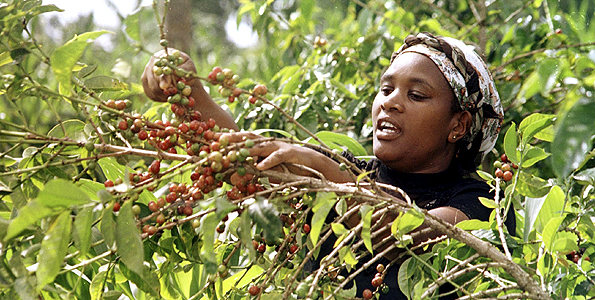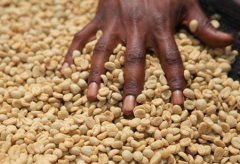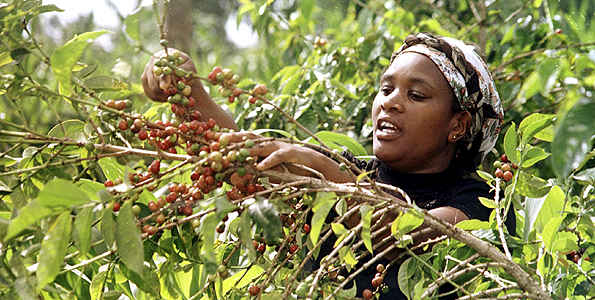Coffee from fruit to raw bean dry washing semi-washing refined Colombian coffee beans
Coffee changes from fruit to raw bean
In the middle of the fruit of coffee is a pair of oval seeds, which are covered with outer skin, inner pulp and pulp. Ripe fruit spoils in a short time without treatment. Refining is to remove the skin and pulp of the coffee fruit, and then take out the seeds. Generally speaking, about 1 kg of raw coffee beans can be obtained from 5 kg of coffee fruit.
There are three refining methods: drying type, water washing type, and compromise between the two-semi-washing type.
Drying refining method:
After the fruit is harvested, the raw beans are dried, shelled and taken out by natural (sun) drying or machine drying. The method of natural drying is to pile up the fruit in the open air and dry it in the sun. To avoid uneven drying or fermentation, it must be stirred at the right time.
The cherry-red fruit will turn black after a week in the sun, and the skin and flesh will become hard and easy to take off. At night, cover with a tarp to block the night dew and make it a black "dry cherry".
The natural drying method has the advantages of simple operation process, low equipment investment and relatively low cost, but it is subject to weather conditions and takes time, so it is easy to be mixed with too many impurities such as defective beans.
The most famous mocha in Yemen. Mokha Mattari (Matali) coffee. It has a unique sour taste and mellow thickness. It is the representative of natural drying, and like Mantenin in Sumatra, beans have irregular appearance and a lot of impurities. Originally, when it comes to Ethiopia, the best-known mocha is refined by natural drying. Mokha Harrar coffee, but recently there has been an increase in Ethiopia's water-washed coffee beans. Sidamo and Djimmah have gradually switched to water-washing refining, and these high-end products are mainly exported to Europe.
Washing type refining method:
The method of washing refining began in the mid-18th century. In the refining process, the pulp of the coffee fruit is first removed, then the residual mucous membrane on the inner pericarp is removed by a fermentation tank, and the beans are washed and dried. The difference between non-washing refining and water-washing refining is that the non-washing refining method dries and then removes the pulp, while the washing method removes the pulp and then dries.
The washing refining method can remove impurities and defective beans through each step, so the appearance of raw beans is uniform, it is generally considered to have high quality, and the trading price is higher than that of coffee beans refined by natural drying.
The biggest disadvantage of water-washed coffee is that the coffee beans are easy to get the smell of fermentation during fermentation, and the beans will be stained with the smell of fermentation, most of which are due to the lack of management and maintenance of the fermentation tank. Soak the coffee beans with mucous membrane on the endocarp in the fermentation tank for one night to remove the mucous membrane. However, if the fermentation tank is not cleaned completely, excessive changes in temperature and humidity will cause changes in the microorganisms in the fermentation tank, which will cause coffee beans to be stained with fermented flavor.
Semi-washing refining method:
This is the discount between drying type and washing type. The practice is to wash the harvested coffee fruit, remove the skin and pulp mechanically, dry it with sunlight, and then dry it with a machine. It is different from the washing refining method in that the coffee fruit is not put into the fermentation tank in the process, and the quality is more stable than the drying refining method. The Silado region of Brazil adopts the semi-washing refining method.
Colombia La Esperanza Geisha Natural
Country: Colombia
Grade: AA TOP
Producing area: Cauca Valley
Altitude: 1800 m
Treatment: insolation
Variety: Rose summer
Manor: hope Manor
Flavor: berries, honey, vanilla, sweet juice

Important Notice :
前街咖啡 FrontStreet Coffee has moved to new addredd:
FrontStreet Coffee Address: 315,Donghua East Road,GuangZhou
Tel:020 38364473
- Prev

Introduction of boutique coffee bean manor-- Costa Rican coffee goddess coffee manor
Citrus, maple syrup, red cherry, vanilla, a variety of fruits compound sweet and sour. This cup of coffee is called "Goddess". Today, Chongqing Brista Coffee training School will introduce you to a coffee bean produced by the Goddess Manor of Costa Rica in the United States. Goddess beans is a micro-batch Geisha (Rosa / geisha) variety of the Goddess Manor (Dota El Diosa) in Costa Rica, Central America.
- Next

Dry water washing roasted coffee beans raw beans Ethiopian Sidamo sun treatment Lion King
The appearance of dry coffee is different from that of water-washed coffee: the water content of water-washed coffee is 12% Mel 13%, and that of dry coffee beans is 11% Mel 12%. Outwardly, the former looks darker green. Generally speaking, the raw beans with higher water content are mostly green or cyan, while those with less water content are brown or close to white. Raw beans are refined by washing.
Related
- Does Rose Summer choose Blue, Green or Red? Detailed explanation of Rose Summer Coffee plots and Classification in Panamanian Jade Manor
- What is the difference between the origin, producing area, processing plant, cooperative and manor of coffee beans?
- How fine does the espresso powder fit? how to grind the espresso?
- Sca coffee roasting degree color card coffee roasting degree 8 roasting color values what do you mean?
- The practice of lattes: how to make lattes at home
- Introduction to Indonesian Fine Coffee beans-- Java Coffee producing area of Indonesian Arabica Coffee
- How much will the flavor of light and medium roasted rose summer be expressed? What baking level is rose summer suitable for?
- Introduction to the characteristics of washing, sun-drying or wet-planing coffee commonly used in Mantenin, Indonesia
- Price characteristics of Arabica Coffee Bean Starbucks introduction to Manning Coffee Bean Taste producing area Variety Manor
- What is the authentic Yega flavor? What are the flavor characteristics of the really excellent Yejasuffi coffee beans?

